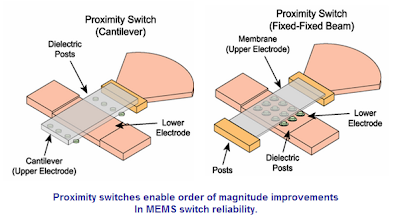Reliability Enhancements
Despite the demonstrated performance advantages of RF MEMS switches, the technology to manufacture reliable, environmentally robust devices is still maturing. The dominant reliability issue with capacitive RF MEMS switches is charging of the switch dielectric. Switching voltages across a thin dielectric layer causes electrical charges to tunnel into the dielectric and become trapped within the insulator. As yet, the underlying physics of the charge tunneling and trapping is not well understood. Most of the present knowledge of this phenomenon has come from empirical measurement of the switches.
One novel method of circumventing the charging phenomena is by trading off switch performance for lifetime. Proximity switches, being developed by MEMtronics, enable low loss, effective operation at microwave and millimeter wavelengths without the detrimental effects of charging on switch lifetime. These switches have the potential for operating for > 100 billion cycles and handling hot switching at multi-watt power levels. At microwave and millimeter-wave frequencies, the reduced capacitance ratio of these switches (Con/Coff ~20-40) is still sufficient for constructing high-performance phase shifters and tunable filters.
Despite the demonstrated performance advantages of RF MEMS switches, the technology to manufacture reliable, environmentally robust devices is still maturing. The dominant reliability issue with capacitive RF MEMS switches is charging of the switch dielectric. Switching voltages across a thin dielectric layer causes electrical charges to tunnel into the dielectric and become trapped within the insulator. As yet, the underlying physics of the charge tunneling and trapping is not well understood. Most of the present knowledge of this phenomenon has come from empirical measurement of the switches.
One novel method of circumventing the charging phenomena is by trading off switch performance for lifetime. Proximity switches, being developed by MEMtronics, enable low loss, effective operation at microwave and millimeter wavelengths without the detrimental effects of charging on switch lifetime. These switches have the potential for operating for > 100 billion cycles and handling hot switching at multi-watt power levels. At microwave and millimeter-wave frequencies, the reduced capacitance ratio of these switches (Con/Coff ~20-40) is still sufficient for constructing high-performance phase shifters and tunable filters.
The key to proximity switches is separating the mechanical support structure from that of the electrical coupling mechanism. This allows the switch to operate with little or no dielectric charging, the dominant mechanism that limits the lifetime of MEMS capacitive switches. Dielectric supports made of silicon nitride or silicon dioxide keep the upper electrode supported a short distance above the lower electrode. The electrical coupling of RF energy from the upper plate to the lower plate is accomplished capacitively through the air gap between the two plates. As most circuit designs can be made quite robust with respect to switch on-capacitance, capacitance ratio can be exchanged for improved switch lifetime.
The proximity switch has several distinct advantages compared to prior designs of capacitive RF MEMS switch:
Absolutely no charging of the gas occurs between the plates. The only charging that may occur is through the mechanical (dielectric) supports maintaining the spacing between the two plates, a very small proportion of the total switch area. This enables the switches to operate with extremely long lifetimes.
Maintaining an air gap between the plates reduces the sensitivity of switch performance to particle contamination. This increases the environmental robustness of the switch.
Lack of dielectric charging also makes these switches ideal candidates for space-based applications, where the impact of radiation on the switch would normally be a reliability issue.
These features make the proximity switch an excellent candidate as a next generation MEMS switch. It is expected that this switch embodiment will have greater than 10x improvement in switch lifetime due to the lack of dielectric charging.
Asignatura: CRF
Direccion: http://www.memtronics.com/page.aspx?page_id=15
Ver blogg: http://lennyramirez-crf.blogspot.com/

No hay comentarios:
Publicar un comentario